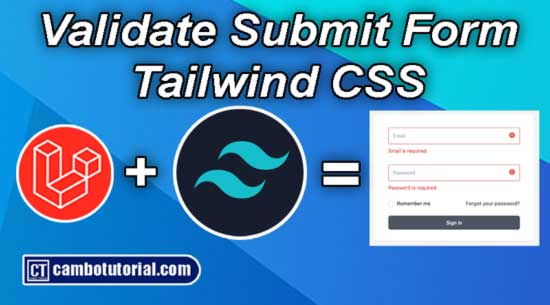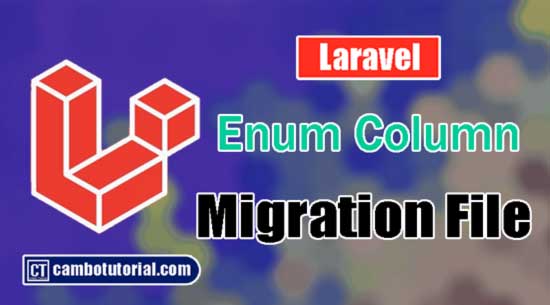Laravel Ajax GET Data Request Example Tutorial
5 minutes read
Today tutorial, we will use ajax to make request in Laravel as example. For beginner or student want to complete about ajax get request with parameters Laravel then I will show an example with very simple solution. This is right place for you to learn and experience Laravel tutorial to make simple ajax request with parameter and show detail information of user or any data as example. Let's follow steps below to create Laravel ajax with get request to retreived data as example.
For this sample example, we are going to display a list of users with show button detail. After list of user with paging we can click the button then we will show detail data of user in modal dialog by using ajax to retreived data from server. To perform request data in background we will use jQuery ajax to make request in Laravel 8 and Laravel 9 version.
Ajax GET Data Request Example
Table of Contents
- Step 1 - Install Laravel
- Step 2 - Generate User Data
- Step 3 - Create Controller File
- Step 4 - Add Mapping Route
- Step 5 - Create View (Blade File)
- Step 6 - Run Laravel Server
Step 1 - Install Laravel
We are going to install Laravel App by following command will download a fresh empty Laravel project. You can read this to know how to install Laravel project.
Step 2 - Generate User Data
Now we are going to create testing data with Tinker command. Open your terminal and let's follow below code
php artisan tinker
User::factory()->count(30)->create()
Step 3 - Create Controller File
This step we will create a controller file, and should name UserController.php file. In the controller we will create two methods and implement each action required. Let's check and see the following flow to create file and update code below:
Open terminal and command below:
php artisan make:controller UserController
Then check or paste below code:
Open file app -> Http -> Controllers -> UserController.php
<?php
namespace App\Http\Controllers;
use Illuminate\Http\Request;
use App\Models\User;
class UserController extends Controller
{
public function index()
{
$users = User::paginate(5);
return view('users', compact('users'));
}
public function show($id)
{
$user = User::find($id);
return response()->json($user);
}
}
Step 4 - Add Mapping Route
We will add route to web.php to tell where controller and method point to correct URL.
Open file routes -> web.php
<?php
use Illuminate\Support\Facades\Route;
use App\Http\Controllers\UserController;
/*
|--------------------------------------------------------------------------
| Web Routes
|--------------------------------------------------------------------------
|
| Here is where you can register web routes for your application. These
| routes are loaded by the RouteServiceProvider within a group which
| contains the "web" middleware group. Now create something great!
|
*/
Route::get('/users', [UserController::class, 'index']);
Route::get('/users/{id}', [UserController::class, 'show'])->name('show');
Step 5 - Create View (Blade File)
Now we are going to create HTML to render as UI, so in Laravel we have to create a blade file as view.
Create file resources -> views -> index.blade.php
<!DOCTYPE html>
<html>
<head>
<title>Laravel Get Ajax Example - CamboTutorial.com</title>
<link href="https://cdnjs.cloudflare.com/ajax/libs/twitter-bootstrap/5.0.1/css/bootstrap.min.css" rel="stylesheet">
</head>
<body>
<div class="container">
<h1>Laravel Ajax Get Request- CamboTutorial.com</h1>
<table class="table table-bordered data-table">
<thead>
<tr>
<th>ID</th>
<th>Name</th>
<th>Email</th>
<th>Action</th>
</tr>
</thead>
<tbody>
@foreach($users as $user)
<tr>
<td>{{ $user->id }}</td>
<td>{{ $user->name }}</td>
<td>{{ $user->email }}</td>
<td>
<a href="javascript:void(0)" class="btn btn-info" onclick="show({{ route('show', $user->id) }})">Show</a>
</td>
</tr>
@endforeach
</tbody>
</table>
</div>
<!-- Modal -->
<div class="modal fade" id="userShowModal" tabindex="-1" aria-labelledby="exampleModalLabel" aria-hidden="true">
<div class="modal-dialog">
<div class="modal-content">
<div class="modal-header">
<h5 class="modal-title">User Detail</h5>
<button type="button" class="btn-close" data-bs-dismiss="modal" aria-label="Close"></button>
</div>
<div class="modal-body">
<p><strong>ID:</strong> <span id="id"></span></p>
<p><strong>Name:</strong> <span id="name"></span></p>
<p><strong>Email:</strong> <span id="email"></span></p>
<p><strong>Registered Date:</strong> <span id="created_at"></span></p>
</div>
<div class="modal-footer">
<button type="button" class="btn btn-secondary" data-bs-dismiss="modal">Close</button>
</div>
</div>
</div>
</div>
</body>
<script src="https://cdnjs.cloudflare.com/ajax/libs/jquery/3.6.0/jquery.min.js"></script>
<script src="https://cdn.jsdelivr.net/npm/bootstrap@5.0.2/dist/js/bootstrap.bundle.min.js"></script>
<script type="text/javascript">
function show(link)
{
$.ajax({
url: link,
type: 'GET',
dataType: 'json',
success: (data) =>
{
$('#userShowModal').modal('show');
$('#id').text(data.id);
$('#name').text(data.name);
$('#email').text(data.email);
$('#created_at').text(data.created_at);
}
error: (er)=>
{
console.log(er);
}
});
}
</script>
</html>
Step 6 - Run Laravel Server
All steps are done, now it's time to start the server to see the result. Run following command below to activated the server.
php artisan serve
Launch browser and go to http://localhost:8000/users
Thanks for read this making ajax get data request article, hope it would help your project. Have a nice day!
You might Also Like:

Author
As the founder and passionate educator behind this platform, I’m dedicated to sharing practical knowledge in programming to help you grow. Whether you’re a beginner exploring Machine Learning, PHP, Laravel, Python, Java, or Android Development, you’ll find tutorials here that are simple, accessible, and easy to understand. My mission is to make learning enjoyable and effective for everyone. Dive in, start learning, and don’t forget to follow along for more tips and insights!. Follow him
Search
Tags
Popular Articles
-
Laravel 9 Login Multiple Roles using Custom Middleware
16.75K -
Drag Drop File Upload with Dropzone.js in Laravel 8, Laravel 9
14.06K -
Laravel Mail - Laravel 9 Send Email Tutorial Example
12.22K -
How to Generate Dummy Data in Laravel 9
3.05K -
How to Install Laravel 9 PHP Framework
2.6K -
How to Upload File in Laravel 9 with Example
2.57K









